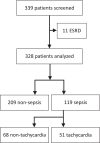Tachycardia and Acute Kidney Injury among Critically Ill Patients with Sepsis: A Prospective Observational Study
- PMID: 38870917
- PMCID: PMC11309051
- DOI: 10.1159/000539808
Tachycardia and Acute Kidney Injury among Critically Ill Patients with Sepsis: A Prospective Observational Study
Abstract
Introduction: Tachycardia caused by sympathetic overactivity impairs myocardial function and raises septic patients' mortality. This study examined whether tachycardia is associated with acute kidney injury (AKI) period-prevalence among critically ill patients with and without sepsis.
Methods: In 328 patients (119 sepsis and 209 non-sepsis) admitted to our intensive care unit (ICU), we assessed heart rate at ICU admission, plasma neutrophil gelatinase-associated lipocalin (NGAL) and N-terminal pro-B-type natriuretic peptide, and urinary L-type fatty acid-binding protein and N-acetyl-β-<sc>d</sc>-glucosaminidase (NAG) at 0 and 48 h after admission. Tachycardia was defined as a heart rate above 100 beats/min.
Results: Tachycardia was independently correlated with AKI prevalence during the first week after ICU admission in the septic patients, but not in the non-septic patients. A dose-dependent increase in AKI period-prevalence was observed across ascending heart rate ranges. Furthermore, we discovered a dose-dependent increase in renal biomarker-positive patients regarding plasma NGAL and urinary NAG over increasing heart rate ranges 48 h after admission.
Conclusion: The findings revealed an independent relationship between tachycardia and AKI prevalence during the first week of ICU in septic patients. Heart rate was found to have a dose-dependent effect on AKI prevalence and renal insult monitored by biomarkers.
Keywords: Acute kidney injury; Biomarker; Sepsis; Tachycardia.
© 2024 The Author(s). Published by S. Karger AG, Basel.
Conflict of interest statement
The authors have no conflicts of interest to declare.
Figures



Similar articles
-
Plasma and urine neutrophil gelatinase-associated lipocalin in the diagnosis of new onset acute kidney injury in critically ill patients.Crit Care. 2014 Jul 1;18(4):R137. doi: 10.1186/cc13958. Crit Care. 2014. PMID: 24985156 Free PMC article.
-
Plasma and urine neutrophil gelatinase-associated lipocalin in septic versus non-septic acute kidney injury in critical illness.Intensive Care Med. 2010 Mar;36(3):452-61. doi: 10.1007/s00134-009-1724-9. Epub 2009 Dec 3. Intensive Care Med. 2010. PMID: 19956924
-
Repulsive guidance cue semaphorin 3A in urine predicts the progression of acute kidney injury in adult patients from a mixed intensive care unit.Nephrol Dial Transplant. 2014 Jan;29(1):73-80. doi: 10.1093/ndt/gft414. Epub 2013 Oct 28. Nephrol Dial Transplant. 2014. PMID: 24166457 Free PMC article.
-
The use of plasma and urine neutrophil gelatinase associated lipocalin (NGAL) and Cystatin C in early diagnosis of septic acute kidney injury in critically ill patients.Dis Markers. 2013;34(4):237-46. doi: 10.3233/DMA-130966. Dis Markers. 2013. PMID: 23396290 Free PMC article.
-
Neutrophil gelatinase-associated lipocalin: ready for routine clinical use? An international perspective.Blood Purif. 2014;37(4):271-85. doi: 10.1159/000360689. Epub 2014 Jul 3. Blood Purif. 2014. PMID: 25012891 Free PMC article. Review.
Cited by
-
Clinical Profile of Acute Kidney Injury in Type 2 Diabetes Mellitus Adult Patients Presenting With Diabetic Ketoacidosis: A Cross-Sectional Study.Cureus. 2025 Mar 6;17(3):e80183. doi: 10.7759/cureus.80183. eCollection 2025 Mar. Cureus. 2025. PMID: 40190975 Free PMC article.
References
-
- Magder SA. The ups and downs of heart rate. Crit Care Med. 2012;40(1):239–45. - PubMed
-
- Hayase N, Yamamoto M, Asada T, Isshiki R, Yahagi N, Doi K. Association of heart rate with N-terminal pro-B-type natriuretic peptide in septic patients: a prospective observational cohort study. Shock. 2016;46(6):642–8. - PubMed
-
- Morelli A, Ertmer C, Westphal M, Rehberg S, Kampmeier T, Ligges S, et al. . Effect of heart rate control with esmolol on hemodynamic and clinical outcomes in patients with septic shock: a randomized clinical trial. JAMA. 2013;310(16):1683–91. - PubMed
-
- Kakihana Y, Nishida O, Taniguchi T, Okajima M, Morimatsu H, Ogura H, et al. . Efficacy and safety of landiolol, an ultra-short-acting β1-selective antagonist, for treatment of sepsis-related tachyarrhythmia (J-Land 3S): a multicentre, open-label, randomised controlled trial. Lancet Respir Med. 2020;8(9):863–72. - PubMed
Publication types
MeSH terms
Substances
LinkOut - more resources
Full Text Sources
Medical
Miscellaneous

